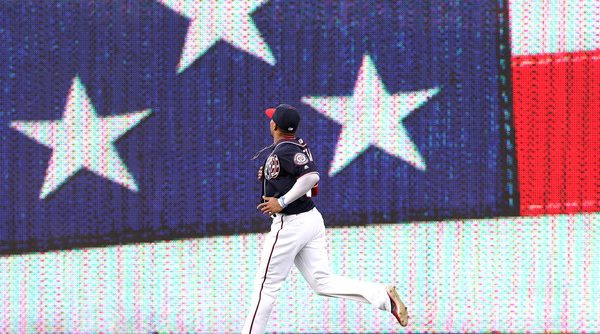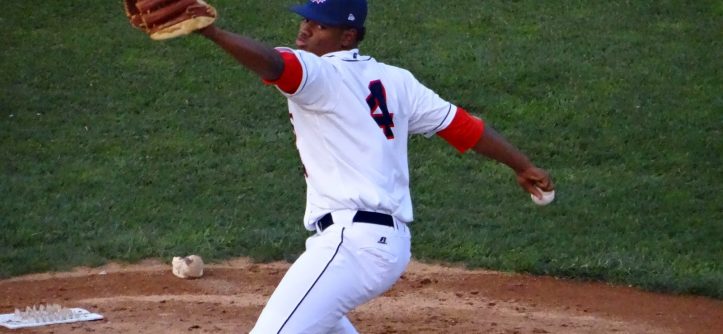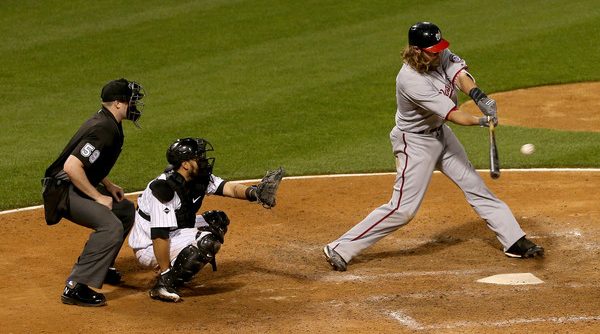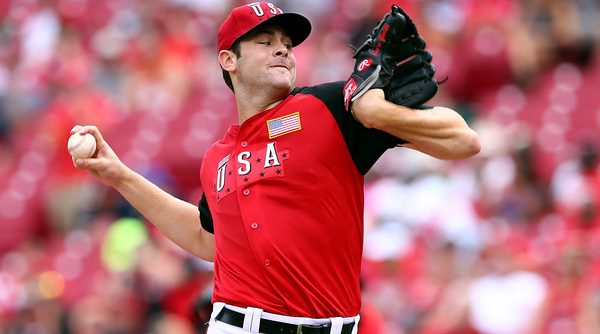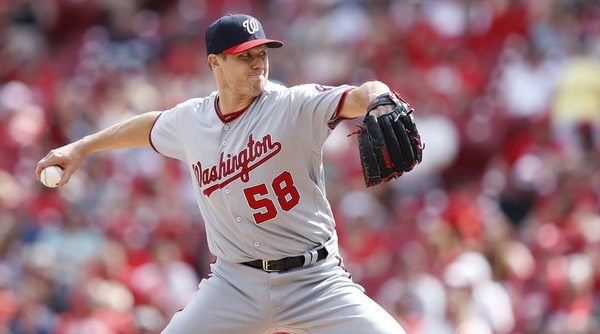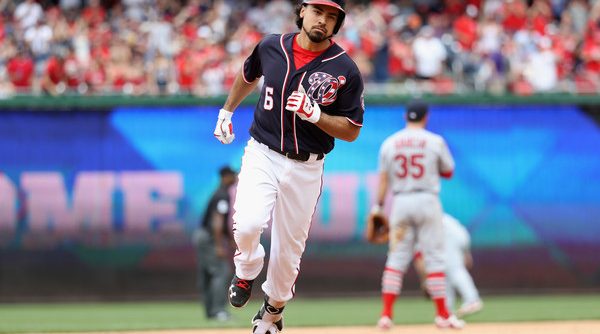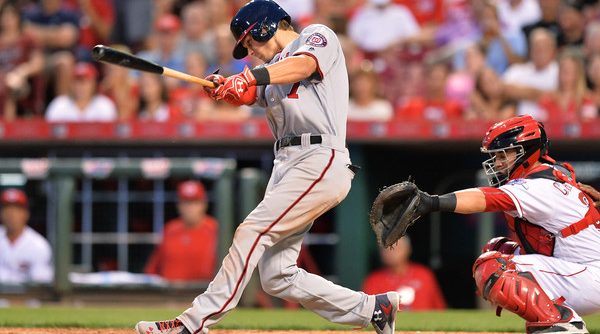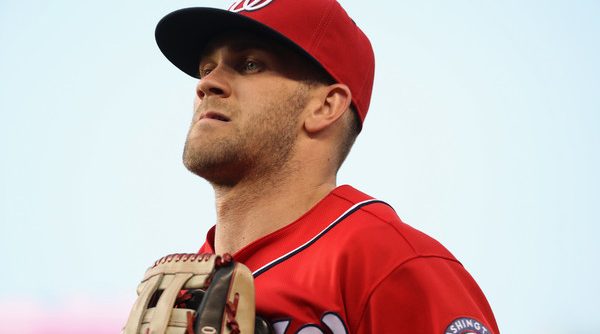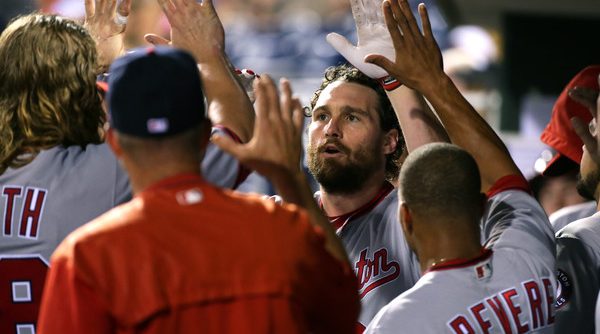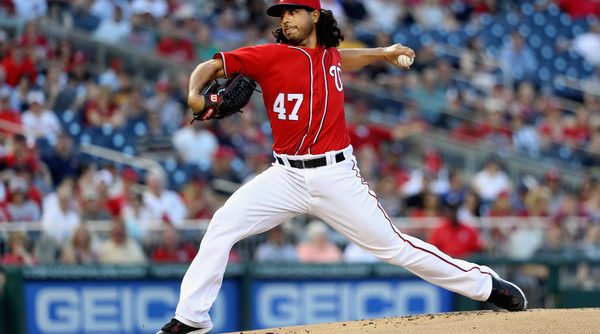Ben Revere started off this season on the DL after he strained his oblique in the first game of the year. He returned after a month to assume the leadoff-man duties and has been, shall we say, less than effective for the Washington Nationals. When the calendar turned to June, Revere picked things up a bit hitting .286 and – more importantly – getting on base at a .375 clip, but let’s take a deeper look at what is ailing Ben Revere, otherwise known as the leadoff man not playing like a leadoff man.
Archives
Federal Reserve: May Hitter and Pitcher of the Month
The month of May brought about a few highlights from the Washington Nationals farm system, but two players in particular stood out for their performances. This week’s Federal Reserve recaps the success of these players with hitter and pitcher of the month awards.
Continue Reading Federal Reserve: May Hitter and Pitcher of the Month
The History of the Nationals’ Designated Hitter
Prior to the Nationals’ come-from-behind win over the White Sox on Tuesday night, Dusty Baker had to do something out of the ordinary: he had to put together a line up with a designated hitter. It’s a situation the Nationals find themselves in more now than in past seasons with the new interleague scheduling. But I’m still not used to it. Seeing Jayson Werth listed as the DH got me thinking: Who has gotten the nod at DH the most in Nationals’ history?
The top 10 list is a fun trip down memory lane. There are the usual suspects and then some names that make you stop and think. Continue Reading The History of the Nationals’ Designated Hitter
Projecting the Nationals’ Draft
The MLB Draft is just two days away, but with the 28th and 29th picks in the first round, there is still a very wide range of players the Nationals could take. I’m not a scout, and I don’t have any sources, but there’s another way to get a glimpse into what the Nationals’ front office might be thinking. I looked at mock drafts and some past draft trends to highlight some players the Nats might consider.
First, the mocks. In the interest of a large sample size, I drew from 24 different mock drafts, on a scale from very reputable (multiple from Baseball America, ESPN’s Keith Law, MLB.com’s Jim Callis and Jonathan Mayo) to the sketchy (the rest of them). I didn’t include any that were obviously from people who knew nothing, so all of them include some scouting knowledge or semblance of inside information. While mocks do get more accurate as we near the day of the event, a broad range of views should paint a good picture. And the results turned out quite conclusive.
Appearing in nearly half of the drafts at 11, and six more time than any other player, was high school shortstop Drew Mendoza. The Florida native is perhaps the draft’s most polarizing player, rating 14th on ESPN’s Jim Bowden’s top draft prospects, 43rd on Baseball America’s list, and 90th on Law’s Big Board. At 6’4” and 200 pounds, he is likely to move from shortstop. With a sweet lefty swing and an arm that ESPN’s Eric Longenhagen called “plus-plus”, or borderline elite, Mendoza could be excellent at third if he gains power as he matures. But Longenhagen says Mendoza is inconsistent at the plate, and his defense could force a move to the outfield. In sum, the report reads, Mendoza is “as high-risk, high-reward as it gets in this draft.”
The connection to Mendoza makes sense beyond his profile on the field. He is represented by Scott Boras, with whom the Nationals have a well-established relationship. He is also likely to be a challenging sign due to bonus demands. But many mock drafters highlighted the Nats’ proclivity to draft and sign the best player regardless of why they fell, as evidenced by players like Lucas Giolito. Mendoza is rumored to want $3 million, and the Nats’ two first-round picks combine for a slot value of just over $4 million. It’s hard to ignore the factors at work here, but no pick is ever a sure thing.
In a distant second in the mock draft tally was Georgia righty Robert Tyler, who appeared five times. Tyler has struggled with inconsistency and injury, but at his best he wields a fastball touching 99 MPH and an excellent changeup. But without a good breaking ball and with command that comes and goes, Tyler would be another high-risk selection for the Nats.
The only other players to appear more than twice were Louisville closer Zack Burdi and Stanford righty Cal Quantrill, who were both mentioned three times. Burdi touches 100 with his fastball and has the makings of two good offspeed pitches, leading some to believe he can start, but his command leaves something to be desired. Quantrill missed this past season recovering from Tommy John surgery, seemingly making him a prime Nationals target. But he seems likely to be gone before the Nats pick, perhaps to the Padres at 24th overall.
The other players to appear more than once were UVA catcher Matt Thaiss, high school lefty Kyle Muller, high school shortstop Carter Kieboom (brother of the Nats’ Spencer), Florida outfielder Buddy Reed, Vanderbilt outfielder Bryan Reynolds, and high school lefty (and recent Tommy John recipient) Jesus Luzardo.
Another way to figure out whom the Nationals might draft includes a look into the past. By examining their past selections, we can attempt to identify traits the team likes in its players.
On the surface, there are few obvious trends. Of the 12 players the Nats have chosen in the top two rounds from 2010 through 2015, which are the six drafts Mike Rizzo has overseen as General Manager, six are hitters and six are pitchers. Eight have been from college, perhaps indicating a slight lean. But a closer look reveals some far more predictive patterns.
The most famous Nats trend, of course, is choosing pitchers who may need or are recovering from Tommy John surgery. Giolito and Erick Fedde are the two prime examples. In this year’s draft, Quantrill and Luzardo are the two main candidates, though Quantrill is expected to go earlier and Luzardo later. Later-round players include Tennessee’s Kyle Serrano and WVU’s Chad Donato.
If that preference extends to pitchers who have had Tommy John and since returned to action, the Nationals could look at Vanderbilt’s Jordan Sheffield, Oregon’s Cole Irvin and Matt Krook, and South Carolina’s Braden Webb.
As mentioned with Mendoza, the Nationals love Boras clients. It’s harder to find agent information before the draft, but Boras represents high school righty Reggie Lawson and college starter Kyle Funkhouser, whose stock has fallen since he chose not to sign with the Dodgers last year. Law recently said that the Nationals could select Funkhouser in the third round.
Studies have suggested that players who are young relative to their peers do much better after being selected, and it seems the Nationals adhere to that idea. They chose Max Schrock and Rhett Wiseman, who were the second- and 14th-youngest college position players last year, respectively, according to Baseball America. Second-round pick Andrew Stevenson was just a week older than the last player (17th-ranked) on that list. Baseball America has not released the youngest players for this year’s draft, and I don’t know where to find that information, but rest assured that I will tweet it when it is released. You’ll likely see one of those players chosen by the Nats.
The Nationals, like many teams, also have a history of choosing players they’ve drafted before. An incomplete list of past examples includes David Kerian, Brett Mooneyham, Jake Jefferies, Nick Lee, John Simms, and Tyler Moore, who the Nats famously chose three times. So for this year’s draft, look out for high schoolers the Nats chose in 2013 who didn’t sign. Of those players, a few have found college success: Long Beach State SS Garrett Hampson (22nd round in 2013, No. 156 on Baseball America’s rankings this year), Mississippi State OF/RHP Reid Humphreys (36th round, No. 206), and Florida RHP Shaun Anderson (40th round, No. 151). The Nationals could also attempt to draft some of the college players they failed to sign last year, like WVU reliever Blake Smith and Rice catcher J.C. Reeves.
A common maxim in drafts in that it is ideal to draft the best player available, as opposed to choosing one that meets a team’s needs. That is especially true in the MLB draft, when players very rarely reach the majors within two years of being drafted. But what may be more of a consideration for teams is drafting to address organizational need. For example, the Nationals’ system has a dearth of left-handed pitchers, the best of whom could well be Low-A starter Taylor Hearn, who has not pitched since breaking his foot in April. The pipeline also lacks corner infielders and power hitters, as Drew Ward may be the only notable example of both, though Kelvin Gutierrez and Anderson Franco are both up-and-coming.
The Nats could also have to consider what positions are logjammed in the organization. Ward, Gutierrez, and Franco occupy third base at High-A, Low-A, and short-season A respectively. If the Nationals were to choose a college third baseman, where would he play?
These lists may seem scattered, but these factors are some of many that the Nationals consider when deciding who to choose. Individually, they don’t tell you a ton. But put them all together, and the puzzle of what the Nats’ draft will look like starts to come together.
Could the Nats Find a New Closer Without a Trade?
Though the Washington Nationals won on Sunday, the debate concerning their closer role seems to only be getting louder. In a tight bottom of the ninth against the Cincinnati Reds, Jonathan Papelbon allowed one runs on two hits and walked a pair of batters before getting out of a bases-loaded, one-out jam.
The end result was his 15th save of the season, but the performance is unlikely to silence the doubts that have mounted. There have been two reports within the last week—one from Ken Rosenthal of Fox Sports, and another from MLB.com’s Bill Ladson—that the Nationals may explore the trade market for relief help, with Ladson citing a source that says that the team feels that “they can do better” in the closer’s role.
With Papelbon’s velocity and strikeout rates declining, it is fair to question if his stuff will allow him to be a viable option throughout the year. For that reason, the trade rumors will likely persist until the August 1 deadline. However, one possibility that is worth considering is whether the Nationals can stall or completely avoid a trade by going with an internal option.
Looking at the club’s other bullpen options, Shawn Kelley stands out. He has been one of the best relievers in all of baseball this year and has shown better control since the beginning of last season while maintaining strong strikeout numbers.
One minor quibble that can be made about Kelley is that most of his major league experience has come in medium, or low-leverage situations. That should not be held against him, however, as his success against hitters on both sides of the plate, ability to generate softer contact at a higher rate than Papelbon, and peripheral numbers — including a 2.47 FIP and 2.82 xFIP entering Sunday — make him worthy of consideration.
Beyond Kelley, the Nationals’ options come with their own set of question marks. Felipe Rivero possesses more prototypical closer’s stuff—and while his excellent strikeout-to-walk numbers indicate that he is better than what his 5.21 ERA suggests—it might take a more consistent stretch of production for him to be considered. Sammy Solis has earned favor with Dusty Baker, but his lack of experience could limit him to long and middle relief situations, also scenarios in which Oliver Perez and Yusmeiro Petit are likely to stay. That leaves Blake Treinen, who has excellent stuff but whose inability to avoid hard contact against lefties has continued this year.
Should the Nationals look to their farm system for help, Koda Glover’s name will undoubtedly arise. The eighth-round selection from last year has stood out among relief prospects, dominating at High-A Potomac before his promotion to Double-A Harrisburg, where he has fanned 22 batters in 15 2/3 innings. The New York Post’s Joel Sherman wrote Sunday that “every scout I speak with says (Glover) is a young Trevor Rosenthal.” Glover possesses the makings of a late-inning reliever, but it remains to be seen if the Nationals will make an aggressive push during his first full season.
There are numerous options at Triple-A Syracuse with prior major league experience—including Abel De Los Santos, Trevor Gott, and Matt Grace — though none stand out as potential closers. Speculation might arise that a starting prospect — such as Reynaldo Lopez — could move to the bullpen to provide short-term insurance, but that seems like a rash decision and one that goes against the Nationals’ habits in developing major league starters.
If Papelbon’s inconsistencies continue, the Nationals should give Kelley the opportunity to close. He is their best internal option, and may allow them to avoid trading for a closer for the second consecutive summer.
Rendon’s Rebound
Back in late April, there was lots of concern over Anthony Rendon. I even wrote up an analysis of what was going wrong with Tony Two Bags, since lost in the tubes of the internet. That’s probably for the best because Anthony Rendon has been hitting .289/.394/.471 with four home runs since April 29, 37% better than the league average according to wRC+. And that’s prior to Saturday’s game, where Rendon went 1-for-3 with a two run home run.
There were legitimate reasons to worry about Rendon at the start of the year. He struggled with injuries and subpar performance for the better part of 2015. He followed that up over the first three weeks of the 2016 season where he hit only .229 with a sub .300 OBP and zero home runs. Despite the poor surface numbers, there were signs of a breakout coming. His BABIP was well below the league and Rendon’s own average at .264. His soft hit rate as only 17%, so he was consistently hitting the ball hard as anyone watching those early games can attest to. Even sitting on April 28 with a .229 batting average, no one wanted to give up on Rendon.
From that point forward, though, Rendon has looked like the Rendon of old. He’s seen those hard hit balls start falling for base knocks as his BABIP has risen up to .360 since April 29. That power that was missing early in the year came back with a vengeance. Rendon knocked those five home runs mentioned before and he’s tacked on eight doubles and one triple for good measure. He’s even been more aggressive on the basepaths with six successful stolen bases in eight attempts. All of a sudden, the Nats have the Rendon of old back and a six hitter they can rely on again.
Back in that first piece examining Rendon’s struggles I theorized that Rendon wasn’t being selective enough. He wasn’t swinging pitches out of the zone. Rather, he was swinging at more pitches than normal in the zone, 76% of pitches in the zone to be exact. In doing do, Rendon was seeing fewer pitches in each at bat and putting balls in play before getting a good pitch to hit. I suggested that Rendon be more patient, let a few more strikes go, in hopes of seeing a pitch he could drive. Starting on April 29, Rendon did exactly that. He’s since swung at only 58% of pitches in the strike zone. By being more patient, he’s found better pitches to hit, gone to the opposite field less and hit for more power.
Now, there is one drawback to this new approach. By taking more strikes, Rendon’s strikeout rate has jumped from 12% to 22%. On the other hand, the more patient Rendon is also taking more walks by nearly doubling his walk rate to 15%. Sacrificing a few strikeouts for more walks and more power is a deal Rendon should be willing to make, he’s a much better hitter by doing so.
It took a few weeks, but the Anthony Rendon stepping up to the plate today is the same hitter who made such a great impression in DC in 2014. He’s patient at the plate, willing to watch a strike on the black go by early in the count in order to find a better pitch to hit later in the at bat. He’s still hitting the ball hard on a consistent basis only now he’s able to turn on the ball and hit to center or pull it to left field. Welcome back, Anthony Rendon.
How Trea Turner Can Use His Speed
On Friday, the Washington Nationals called up Trea Turner from Triple-A for the first time this season. While I will not debate the merits of Danny Espinosa versus Trea Turner — more eloquent writers than myself on The Nats Blog penned many an article on this very topic — I would like to discuss how Turner can take advantage of the one undisputed quality that sets him apart: speed.
Off-The-Field Recap: Sweeping Up
This week the Nationals swept the Phillies, broke their record for pinch hit home runs in a season (thank you Chris Heisey), and hit the 12 games over .500 mark for the first time this season, but they also practiced voodoo, chopped hair, and…
The State of the Nationals: Checking in after one-third of the season
As the Washington Nationals take a well-deserved day off, let’s also take a moment to reflect on the beginning of another baseball season. We’re finally at the point in the year where real conclusions can start to be drawn with a little more certainty. The Nats have played a third of their games and currently lead the NL East with 33 wins.
Normally at this point in the season I don’t give much weight to the pace predictors – that is, people who judge a team’s ultimate success based on how many wins they are on pace for. But With this team on pace to win 99 games I’m thinking more about how they got here than what they will look like going forward. Continue Reading The State of the Nationals: Checking in after one-third of the season
The Gio Gonzalez Debacle: Examining Command vs. Control
Gio Gonzalez came out punching to start the 2016 season. Through his first seven starts, he was on the ERA leaderboard with a 1.93 ERA. His 3.00 FIP and 4.18 xFIP over those seven games, though, indicated that he was unlikely to maintain that stellar ERA. Sure enough, regression hit hard and Gio came crashing back to earth with two back-to-back disastrous starts.
After giving up 13 earned runs to the Mets and Cardinals over only 9 2/3 innings, Gio’s ERA jumped nearly two full points to 3.57 and left Nationals fans scratching their heads, wondering which Gio will show up against the Reds. Continue Reading The Gio Gonzalez Debacle: Examining Command vs. Control

